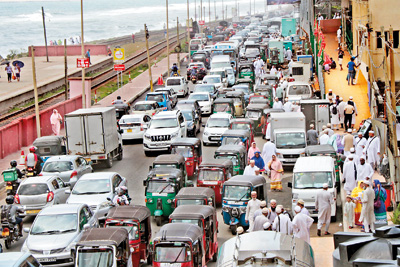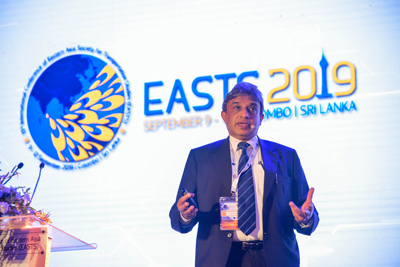News
Time to apply brakes on rapid motorisation: Prof. Kumarage
Less than half of the Sri Lankan population today uses public transport despite bus and rail availability increasing, a leading expert said recently at the Asian Conference on Transport Research held in Colombo.

Motor Vehicle ownership is often used as an indicator of economic prosperity and prestige
Amal Kumarage, Senior Professor at the Moratuwa University’s Department of Transport and Logistics, has traced how Sri Lanka’s motor vehicle fleet developed over 61 years. In 1958, he said, 98 percent of people travelled by public transport. By 1980, this had dropped to 88 percent. But the real shift came in 1977 with the open market economy which allowed free imports.
“And what did people import?” he asked, delivering the keynote address at the conference. “They imported motor vehicles.”
Today, just 48 percent of Sri Lankans use public transport. Another 48 percent travel by private vehicles and the remainder use rail. “Right now, we have seen the beginning of what we call ‘exponential growth’,” he observed. “And we foresee, according to the modelling we do, that public transport will continue to come down to less than 30 percent if we’re unable to make a change to this rapid motorisation.”
The story is common to many developing countries, both low and middle income, Prof Kumarage said, calling for Governments across the globe to manage rapid motorisation.
The conference–called EASTS 2019 for short–was attended by 415 international delegates from 30 countries and 130 local participants. The motor vehicle changed the face of the20th century. Today, there are an estimated 1.4 billion vehicles globally, averaging just under one per household.
Motor Vehicle ownership is often used as an indicator of economic prosperity and prestige and therefore driven by powerful political, social intentions and business interests promoting a large global automotive industry.
Vehicles have positive aspects, such as access to remote places, mobility at higher comfort, the convenience and freedom of on-demand supply of mobility, speedier travel, interaction across large geographical spaces and a huge industry in terms of employment and tax revenues.
“It has also become a symbol of social pride to own a car, to own a better car, maybe to own the best car,” Prof Kumarage said. “Societies have their own pyramid of symbols associated with the car.” Governments, particularly in low and middle income countries use the motor vehicle as an indicator of economic prosperity.

Prof. Amal Kumarage delivering the keynote address
But there are also the negative factors, such as high energy consumption. Motor vehicles “disconnect” the local community, taking people off the street and not allowing them to meet. There is high risk of non-communicable diseases such as obesity and cardiovascular ailments. There is an increase in air emissions and noise pollution. Traffic injuries and trauma are some of the greatest risks to society today.
For countries that do not produce oil, motor vehicles are a drain on their economies. They stratify people by the cars they drive. And they cause urban traffic congestion.
“Colombo, where we are, gives up 16 percent of its land for the purpose of moving vehicles,” Prof Kumarage said. “That’s a large area of very important commercial land.”
Research by Prof Kumarage at the University of Moratuwa examines the theory that countries and cities should determine their own sustainable levels of motorization based primarily on population density. The examples of around 40 high income countries were used to identify the motorisation levels that allowed them to reach that status. It was determined that, in general, while low population density countries use a high level of private vehicles, high population density countries have used the opposite policy to reach high income status.
“If it wasn’t for urban traffic congestion, we would not even think there’s a problem with the car,” Prof Kumarage said. “And, then, people ask us what went wrong so I’m in a way thankful that there is congestion so that we can solve the bigger problem of rapid motorisation.”
“A lot of wealth produced in terms of gross domestic product is now being used for motorisation,’ he said. “It could be used for many other things that make life richer and more meaningful.”
The world currently loses around 1.45mn people a year due to road fatalities. Around 70mn vehicles are produced a year. That compares almost with the number of births per year, which is 82mn. “It seems that, for nearly every person born into this planet, we have a motor vehicle being manufactured,” Prof Kumarage observed. Examination of Sri Lanka’s current motorisation trends shows it does not match population density.
The Western Province, in particular, lags well behind in providing quality public transport. What should be good enough to capture 65% of travel requirements now stands at 45 percent in this region.
The Government must identify that unless motorization is not managed scientifically, the economy is bound to seriously slow down as congestion and accessibility costs increase thus impeding Sri Lanka’s quest for higher income status.
“Sri Lanka is on the wrong curve,” he warned. “We have gone beyond sustainable levels of motor vehicle ownership.”
Nearly 400 technical papers were presented over three days at the conference, covering the full spectrum of research including public transport, aviation, highways, logistics, maritime, traffic, road safety and urban planning.
At the closing ceremony, the Sri Lanka Society of Transport and Logistics (SLSTL) was chosen as the Best Domestic Society for the period 2017-2019. Sri Lanka also bagged three of the 11 awards made for the best research presentations in different areas.

